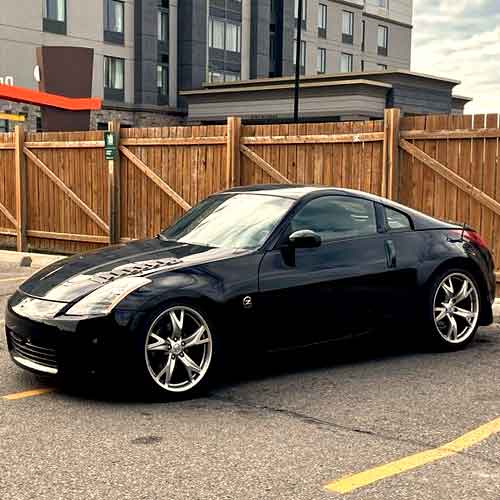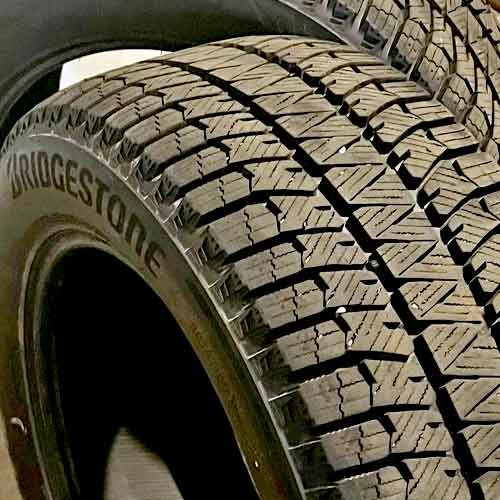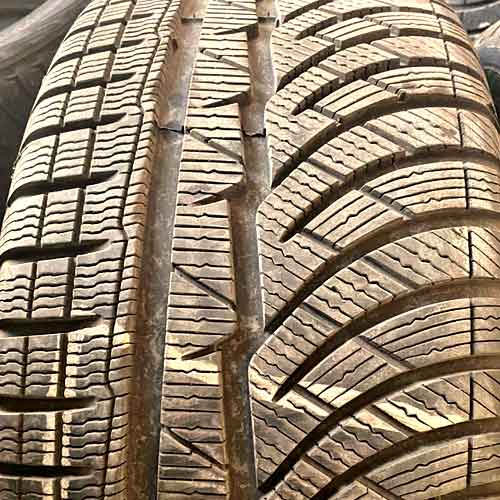Let’s check out a captivating clash between the Michelin Pilot Alpin PA4, known for its impressive snow performance and the Bridgestone Blizzak WS90, famous for its exceptional stability in icy and wet conditions, starting with their sizes info.

Table of Contents
Available Sizes
The Michelin Pilot Alpin PA4 comes in 51 total sizes in 17 to 21 inches (with following specs).
- Speed ratings: H, V and W.
- Load ratings: SL and XL.
- Tread depth: 10.5/32″ on all.
- Weight: 10 to 36 lbs.
- Tread warranty: 30k miles.
On the other hand, the Bridgestone Blizzak WS90 offers 52 total sizes in 15 to 19 inches rims. They come with following specs.
- Speed ratings: T or H.
- Load ratings: SL or XL.
- Tread depth: 11 or 12/32″.
- Weight: 17 to 29 lbs.
- Tread warranty: None.
Tread Appearance
The Blizzak WS90 (review) displays superior engineering with its strong and detailed directional tread design.

The tread consists mainly of three standout ribs (in total), with the central rib forming a continuous band.
This rib is adorned with numerous wave-like sipes and highlights straight, interconnected slits that are expertly combined with in-groove notches.
And those notches are further joined up with V-shaped incisions pointing towards both sides, bolstering the tire’s grip.
Moving towards the shoulders, the lugs there excel in their design, containing notches that face towards the central rib, with additional ones on the sides that match with wide, inclined longitudinal slits.
Moreover, parallel to these slits are zigzag shaped incisions, that further make the blocks aggressive. And of course, you also get similar siping here as well, so that’s that.
On the other hand, Michelin PA4 (review) features a asymmetrical tread design as can be seen.

It’s tread pattern has 4 main ribs in total, where the central one is made continuous.
One side of this central rib is smooth and straight, devoid of edges, while the other side is serrated with the help of sharp edges and notches.
Moreover, this rib contains a mixture of numerous sipes and slanted slits on it.
Moving on, the rib visible on the tread, which is situated towards the serrated side of the central rib, covers majority of the tread’s area.
This rib has chamfered outer edges, and consist of a blend of rectilinear and interlocking siping (oriented at various angles).
Moreover, you also see curving in-groove notches, which are actually running parallel to the lateral tread voids (which split up these blocks form one another).
Moving towards the other side of the tire, you see, things are more packed up here. Though you get similar in-groove notches and longitudinal slits (but they are not splitting the lugs).
Snow Performance
Both boys here exhibit impressive performance in all types of snowy conditions, producing comparable results.
But still if I have to pick one of these, I’d go with the Michelin Pilot Alpin PA4, as the tire shows a slight edge, particularly on fluffy snow surfaces.
Why? Well let me explain.
So this tire features a more aggressive biters all over its asymmetric tread with yield snow to snow contact.
Basically the fluffy snow is readily trapped within the tire’s interlocking grooves and snow-vices, facilitating ground contact with the entrapped snow. This design enhances traction as snow tends to adhere better to other snowflakes than to rubber.
On the other side, the directional Blizzak WS90 with its comparatively crowded lug design isn’t able to offer similar results.
So overall the Michelin takes the lead here.
Ice Performance
When tested on icy conditions, the Bridgestone Blizzak WS90 surpasses its competitor, demonstrating superior braking capabilities with a better average braking distance.
So what cause this tire to stop and accelerate quicker? (as seen on the tests).
Well its performance is credited to its meticulously designed tread features.
It’s central rib with slanted incisions, and V shaped biters, and it’s dual angled siping, all provide amazing biting abilities.
I must say, overall the tire has really excelled over its predecessor when it comes to icy terrains.
The Michelin Pilot Alpin PA4, in comparison, lags behind with larger tread voids and fewer notches.
This tire’s central tread area, crucial for efficient braking, struggles to secure a better grip on packed ice due to wider lateral tread voids.
Moreover, the tire also lacks as much flexibility, as all its ribs have much bigger lugs. This prevents the biters to grip on the slippery icy surface, relatively speaking.
Moreover, although you get angled sipes here too, they don’t posses as much depth, and again aren’t as flexible to bite in to ice as effectively as its counterpart.
All these factors render the Michelin Pilot Alpin as a weaker contender when compared to Blizzak WS90.
Wet Traction
Wet traction primarily depends on the tread design and the rubber compound used in the tire. Both these factors basically tell you about how the tire is when it comes to gripping, and hydroplaning resistance.
Let me talk about them separately.
Wet Grip
So wet grip is highly dependent on siping, and although both tires have ample of that, the ball is still in the Blizzaks court.
On this tire you see 5 feet faster braking, and a while 2 seconds faster handling (on lap tests).
So how come?
Well, this is because the Bridgestone Blizzak has a more thermally adaptive softer rubber compound, and its biters allow for more lug flexibility.
This way its sipes are able to create better suction for the water particles coming underneath (this is how sipes work by the way).
Moreover, the tire’s multi-angled siping further add to that, offering grip in all directions.
The Michelin Pilot Alpin is missing with these features. It’s sipes are also angled but not as flexible.
So overall wet gripping is better on Blizzak, though the tire does better in hydroplaning department.
Hydroplaning
Hydroplaning is a phenomenon that occurs when a layer of water builds up between the tire tread and the road surface, causing the tire to lose contact with the road and glide on the water. It typically happens during wet or rainy conditions when there is a significant amount of standing water on the road.
And here the Pilot Alpin PA4, excels with a good margin especially during cornering.
Basically two tests were performed to calculate this. Straight and Curved Aqua tests. And although the margin between both tires is very small when it comes to straight, the curved test show that the Michelin’s boy is pretty great.
(These tests tell how fast a tire can roll over water, straight, and while cornering).
Dry Traction
Dry grip is also a mixture of two, directional grip, and lateral traction. Lets talk them both one by one.
Directional Grip
This grip is measured when the tire rolls straight. And here the middle section is of utmost importance.
So in case of Blizzak WS90, you get better results as the tire features a more streamlined structure and a continuous running wider central rib allowing for shorter braking distances and acceleration times.
In contrast the Michelin Pilot Alpin PA4 lacks with its wider grooves and asymmetric design (which is not as streamlined in to rolling straight, on highways, for example).
Lateral Traction
This is the sideways grip of a tire and depends on two metrics, contact patch, and the rubber composition.
And considering both one can easily explain why the Michelin Pilot Alpin PA4 is lacking here too.
The tire basically has much wider grooves, which don’t form ample contact with the ground, and with larger weight, its lugs bend a lot more as the tire corners. This leads to over and understeering, causing slower steering feedback.
So yes, overall handling and gripping award goes to Blizzak WS90.
Comfort Levels
Tire comfort is primarily influenced by two metrics, road noise and vibration absorption.
Let’s talk noise first, which is just air particles hitting around the tread.
And since the WS90 features a more closed up tread design, it doesn’t allow air particles to move as freely, and hit the walls with as much force as seen on it louder counterpart.
Though the Alpin PA4 does better in the vibration absorption department, allowing for better soak settling abilities.
So both tires do great here.
Tread Life
Tread longevity is influenced by rolling resistance, and in this regard, the Bridgestone Blizzak WS90 is taking the lead.
The tire’s lighter weight basically puts less pressure on its lugs, as the rub against the road.
On the other side, the Alpin PA4, not only comes out with greater average weight, but with wider grooves, each lug carries much more pressure on itself as it rolls on the ground.
This causes excessive heat, generating greater rolling resistance and therefore exceeding rubber wear.
So the Blizzak WS90 is taking the lead here.
Summing Up
To sum up, the Michelin Pilot Alpin PA4 excels in fluffy snowy conditions, while its counterpart outperforms on packed snow and ice, with shorter braking distances and handling times.
And on dry and wet tar surfaces, the Blizzak WS90 holds the upper hand, although the Michelin Pilot Alpin PA4 demonstrates superior hydroplaning resistance.
But overall, Blizzak is taking the lead with it’s more fuel efficient design which also wear slower. Though in terms of comfort, both tires are rated as equals.